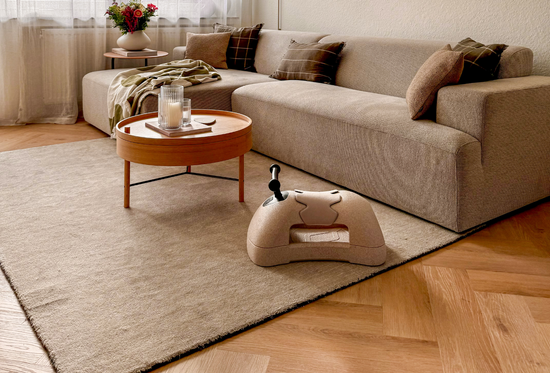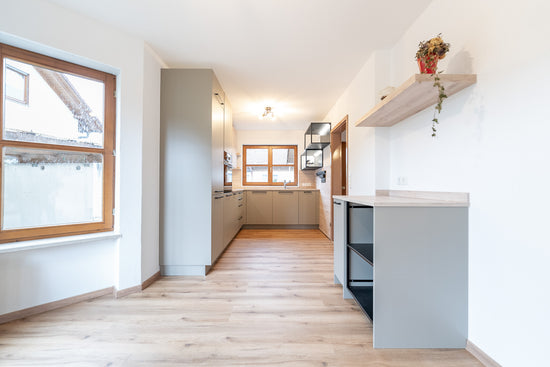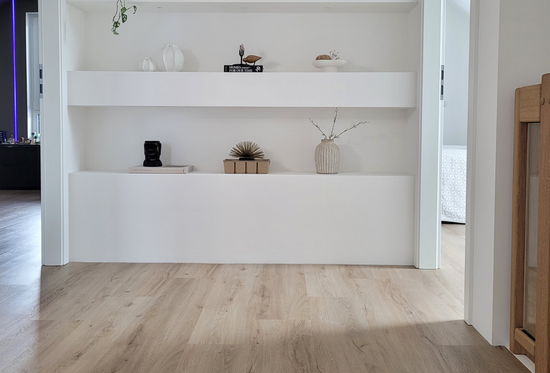Table of contents
- Introduction
- Subfloor preparation
- Room acclimatization of the floor covering
- Observing the manufacturer's instructions
- Maintaining edge clearance
- Correct installation of the first row
- Sufficient offset in the rows
- Planning expansion joints
- Avoiding high point loads
- Fixing and care of the floor covering
- Conclusion
Installing a new floor covering can be an exciting and rewarding task. A fresh floor not only changes the appearance of a room but can also significantly improve comfort and functionality. To make your floor installation a complete success, it is important to avoid some common mistakes. In this guide, you will learn how to avoid typical pitfalls and install your floor professionally and attractively.
1. Insufficient substrate preparation
A common mistake in floor installation is insufficient substrate preparation. An uneven, dirty, or damp substrate can lead to problems such as unevenness in the floor or premature wear of the covering.
Solution: Ensure that the substrate is clean, dry, and level. Remove all old floor coverings and dirt. If necessary, level the substrate or use a suitable primer to improve adhesion.
2. Neglecting room acclimatization
Another mistake is neglecting the room acclimatization of the floor covering. If the floor is not sufficiently adapted to the room conditions, it can warp or swell.
Solution: Allow the floor covering to acclimate in the room for at least 48 hours before installation. This allows the material to adjust to the temperature and humidity.
3. Ignoring the manufacturer's instructions
A common mistake is ignoring the manufacturer's instructions. Every floor covering has specific requirements and recommendations that must be observed.
Solution: Read the manufacturer's instructions carefully and follow them. These instructions often concern the correct installation technique, substrate preparation, and floor care.
4. Missing edge clearance
The failure to maintain sufficient edge clearance is a common mistake. Floor coverings need space to expand and contract without warping.
Solution: Make sure to maintain the edge distance recommended by the manufacturer. Use spacer wedges to ensure the distance.
5. Improper installation of the first row
Mistakes in laying the first row can affect the entire floor area and lead to unsightly shifts.
Solution: Work especially precisely on the first row. Use installation wedges to ensure the correct alignment.
6. Insufficient staggering in the rows
Insufficient staggering between floor planks is a common mistake that can cause problems.
Solution: Make sure the planks in the rows are sufficiently staggered to ensure a stable connection and an appealing appearance.
7. Missing expansion joints
Neglecting expansion joints is a mistake that can lead to deformations such as bulges or cracks.
Solution: Plan and create sufficient expansion joints, especially in larger rooms or with fluctuating temperatures.
8. Excessive point load
Excessive point load, especially from heavy furniture, can damage the floor and cause dents or joint formation. This is particularly true for kitchen furniture. To avoid damage, these pieces of furniture should be decoupled from the floor, as otherwise the point load is too great. (This applies especially to all click coverings.)
Solution: Use felt gliders or furniture pads to distribute the load and protect the floor. Kitchen appliances should also be decoupled.
9. Improper edge fixing
Improper fixing of the floor at the edge, for example with silicone, can restrict the natural movement of the floor.
Solution: Use a round cord to properly apply the silicone and ensure the floor's freedom of movement.
10. Missing care and maintenance
A common mistake is neglecting the care and maintenance of the floor. A well-maintained floor retains its beautiful appearance and functionality longer.
Solution: Follow the manufacturer's recommended care instructions. Regular cleaning and resealing if necessary are important to keep the floor in top condition.
Conclusion
Laying the floor can be a rewarding task if you avoid common mistakes. With careful preparation, attention to the manufacturer's instructions, and precise installation, you can create a floor that not only looks good but also lasts a long time. Pay attention to details




